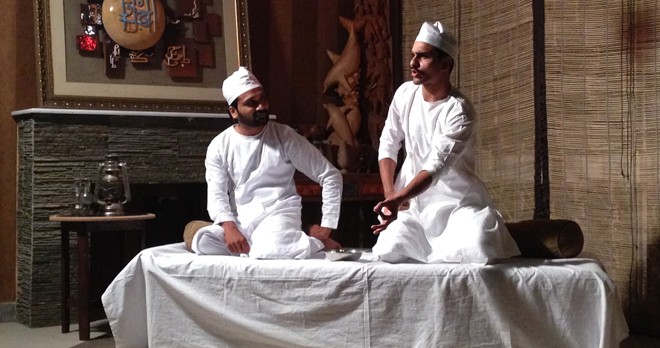

The beautiful city of Lahore has always been a place where countless tales have been told and retold in various literary forms. Recently, Lahore played host to a different kind of story-telling event. Called Daastaangoi, it was a reading of a tale selected from Muhammad Husain Jah and Ahmed Husain Qamar’s compilation of the 15th century Urdu epic, Tilism-e-Hoshruba.
Organised by Olomopolo Media, the tale was narrated by two veteran actors from the National Academy of Performing Arts (NAPA) -- Fawad Khan and Nazrul Hasan -- in the style of the ‘daastaangohs’ of yore.
Performed in a small studio in front of a select number of people, Daastaangoi recreated the ambience that is supposed to have been a hallmark of the Mughal courts.
Attired in crisp white angrakhas and Lakhnvi caps, the two daastaangohs used the strength of their dialogue delivery to transport the audience to the fantastical world of the Tilism chronicles.
Using a simple white takht as their stage, both Khan and Hasan took turns to narrate the tales of magical fantasy that used to hold the courtly audiences captive in the darbars of Lucknow. The diction, gestures and intonation of both orators were so superbly in sync with the genre and the era they were portraying that even the people who may have no prior knowledge of the Tilism chronicles were left with a newfound interest in Urdu fantasy literature. This was exactly the effect that the team of Olomopolo hoped the reading would have on the viewers.
Though Tilism-e-Hoshruba has been in the literary limelight recently due to the publication of an excellent abridged English translation of the chronicles by renowned columnist Shahnaz Aijazuddin, the selection of the Urdu version was a laudable decision. The effort to revive interest in an epic that is the cornerstone of Urdu fictional story-telling fulfills one of the core objectives of Olomopolo Media, a visual and performing arts company owned by Kanwal Khoosat, daughter of veteran actor Erfan Khoosat.
Olomopolo came into being due to Khoosat’s passionate desire to preserve the traditional and culturally relative modes of performing arts.
Housed in an unassuming building in Lahore, the company’s studio is wittily labeled the Olo Junction. Barely six months old, the company is aided by media veterans like Saniya Saeed and Shehnaz Sheikh in providing an alternate platform for the historical forms of the performing arts.
Story-telling has always been an intrinsic part of the cultural of the Indo-Pak sub-continent. Nowadays, due to the rapidly increasing fixation with gadgets, the art of narration is slowly inching towards its demise. Olomopolo intends to remind us once again of the simple pleasures of listening to a story being told, whether by a professional narrator or by a wise elder.
To introduce the youngest members to the art form of story-telling, the organisers at the Olo Junction have set aside two hours every Sunday for kids aged 3-13. Named Olo Tatolo, the weekly workshop treats children to different forms of the performing arts including readings from literature for children. The company is functioning without any corporate funding and hopes to continue holding different workshops without having to deal with the strings attached to sponsorship.
According to Kanwal Khoosat, lack of mainstream marketing as well as their refusal to cash in on the names of industry veterans, is a deliberate decision taken by the team to ensure their studio’s particular identity as a close-knit cultural space is not lost along the way.
As Fawad Khan, one of the daastaangohs, said after the recital (translation), "Stories are the panacea for the depression of the country," the preservation of the historically significant styles of the performing arts will undoubtedly provide creative and intellectual respite from the bleak scenario of our country’s socio-political reality.